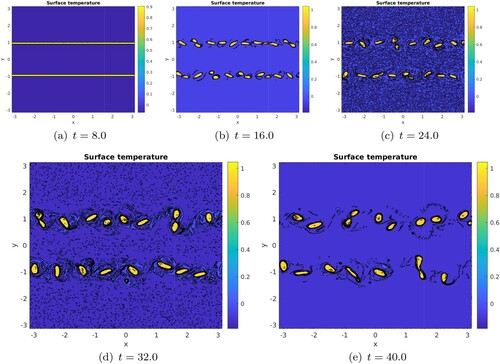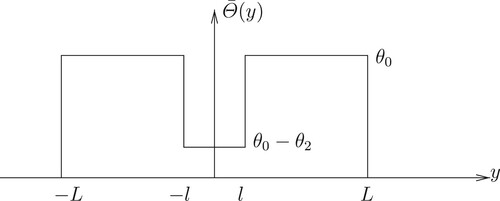Figures & data
Figure 1. Series of temperature maps in the -plane at t = 0, 3, 4.5, 9, 12, 15 illustrating the formation of a row of small vortices at the centre of the merged vortex for
at resolution
. The black lines denote the contours of various temperature levels between 0 and 1. (a) t = 0.0. (b) t = 3.0. (c) t = 4.5. (d) t = 9. (e) t = 12 and (f) t = 15.

Figure 2. Okubo-Weiss quantity OW (left panel) and frontogenetic function FGT map (right panel) in the -plane at time t = 3 illustrating the deformation of the internal front for
at resolution
. The black lines in the left hand panel are the contours of the various levels of the Okubo-Weiss parameter between 0 and the maximal positive or negative values. (a) OW – t = 3.0 and (b) FGT – t = 3.0 (Colour online).
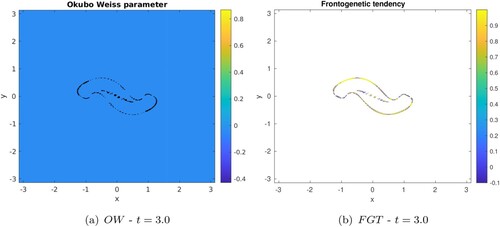
Figure 3. Evolution of the passive tracer distribution in the -plane from left to right then top to bottom at time t = 0, 1.5, 3.0, 4.5 for
at resolution
. The black lines denote the various levels of tracer concentration; their closeness indicates a locally strong tracer gradient. (a) t = 0.0. (b) t = 2.5. (c) t = 3.50 and (d) t = 4.5 (Colour online).
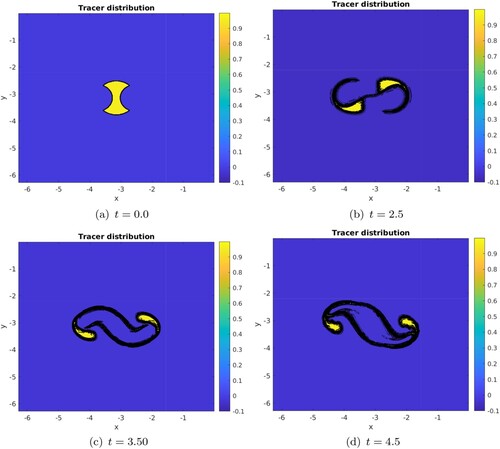
Figure 4. Evolution of the temperature in the -plane at time t = 3.0, 4.5 for top-hat vortices with
(top row), at time t = 4.5, 6.0 for top-hat vortices with
(middle row), at time t = 6.0, 7.5 for smooth vortices with
(bottom row). These simulations were performed at
resolution. The black lines are the contours of the various levels of temperature in the model. Their closeness indicates a high gradient of temperature. (a) t = 3.0. (b) t = 4.5. (c) t = 4.5. (d) t = 6.0. (e) t = 6.0 and (f) t = 7.5.
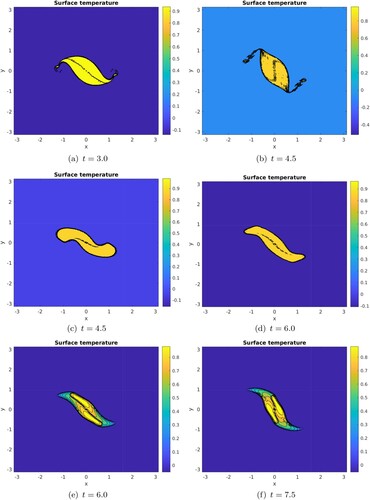
Figure 6. Horizontal structure of the temperature distribution in the perturbed parallel gaped strip.

Figure 7. Growth rates of linear perturbation on the mean temperature profile; the growth rates are displayed in the -plane for
(left column) and in the (kL,
)-plane for
(right column).
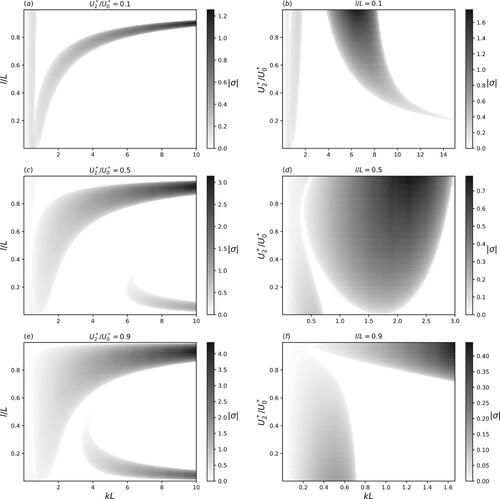
Figure 8. Nonlinear evolution of the unstable parallel temperature distribution with , perturbed with a white noise in temperature with amplitude 0.1 initially, at time t = 0, 8.0, 16.0, 20.0, 24.0 (from left to right and from top to bottom). The lower left plot is a zoom on the central vortex for the last subplot. These simulations were performed at
resolution. The black lines are the various contours of temperature. Their closeness denotes a high gradient of temperature, in particular in the filaments. (a) t = 0.1. (b) t = 8.0. (c) t = 16.0. (d) t = 20.0. (e) t = 24.0 and (f) t = 24.0 – zoom.
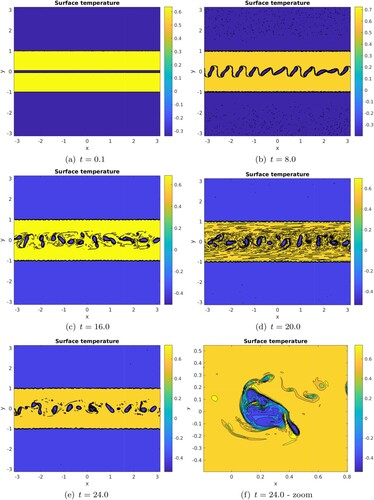
Figure 9. Modal analysis ( is the amplitude of the zonal mode with wavenumber m) for the unstable parallel temperature distribution with
presented in figure .
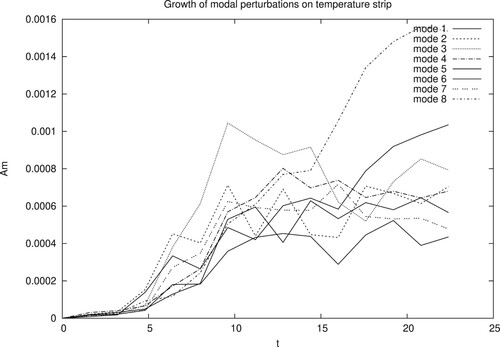
Figure 10. Zoom on the central region of figure at time t = 6.0 and t = 9.0; row of small vortices in the core of the large merged vortex. The black lines indicate the various levels of surface temperature, separating the various colours. (a) t = 6.0 and (b) t = 9.0 (Colour online).

Figure 11. Time evolution of horizontal maps of temperature using the nonlinear spectral SQG model. Times shown are t = 0, 5, 35, 40. The simulation is initialised with 6 small vortices along the major axis of a 2:1 large elliptical vortex. The small vortices have the following radius and separation . This simulation was performed at
resolution. The black lines indicate the various contours of temperature. The temperature gradients are large in the filaments and at the vortex peripheries. (a) t = 0.0. (b) t = 5.0. (c) t = 35.0 and (d) t = 40.0 (Colour online).
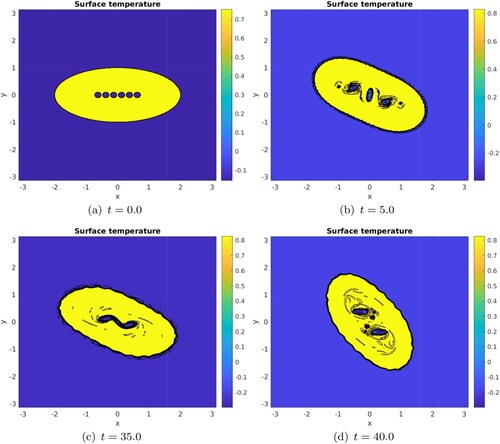
Figure 12. Evolution of horizontal maps of passive tracer for an ellipse without (top) or with (bottom) small central vortices. Times shown are t = 0, 16, 32. The second simulation is initialised with 6 small vortices along the major axis of a 2:1 large elliptical vortex. The small vortices have the following radius and separation . The resolution of this simulation is
. The black lines indicate the various levels of tracer concentration. (a) t = 0.0. (b) t = 16.0. (c) t = 32.0. (d) t = 0.0. (e) t = 16.0 and (f) t = 32.0 (Colour online).
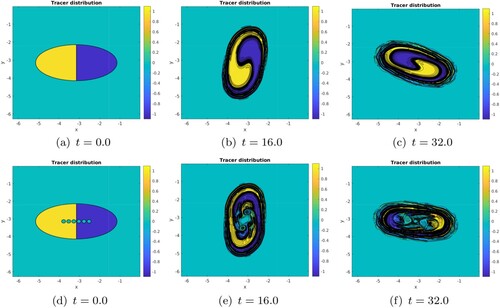
Figure A1. Nonlinear evolution of the unstable parallel temperature distribution with , perturbed with a white noise in temperature with amplitude 0.1 initially, at time t = 0, 12.8, 25.6, 38.4. The black lines indicate the various levels of surface temperature. (a) t = 0.0. (b) t = 12.8. (c) t = 25.6 and (d) t = 38.4 (Colour online).
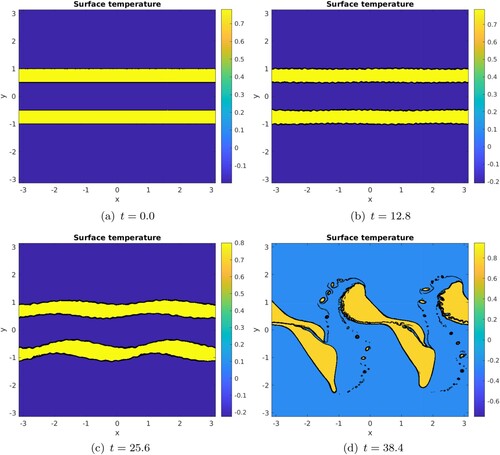
Figure A2. Nonlinear evolution of the unstable parallel temperature distribution with , perturbed with a white noise in temperature with amplitude 0.1 initially, at time t = 0, 8.0, 16.0, 24.0, 32.0, 40.0. The black lines indicate the various levels of surface temperature. (a) t = 8.0. (b) t = 16.0. (c) t = 24.0. (d) t = 32.0 and (e) t = 40.0 (Colour online).
